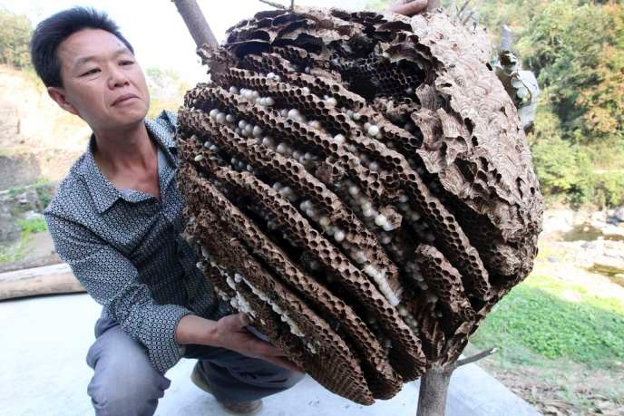 Véto-pharma
Véto-pharma Update on August 5th of 2020: Since the publication of this article, a first Asian giant hornet has been trapped on July 14 in Washington state. You can find more information on the Bee Culture post here: https://www.beeculture.com/catch-the-buzz-washington-traps-first-asian-giant-hornet/
In December 2019, an unusually large hornet was spotted in Washington state by residents of Blaine and Bellingham, near the Canadian border. Similar hornets had also been reported in Canada in two locations in British Columbia in the fall 2019. This hornet was then identified as an Asian Giant Hornet, or Vespa mandarinia. This is the first time this type of hornet has been spotted in North America, and its presence is definitely raising concerns.
Vespa mandarinia is often called “The Giant Hornet”. No wonder why, as it’s the largest species of hornet in the world and biggest species of social insects known to date. There are different kinds of Vespa mandarinia: japonica, nobilis, magnifica, and bellona.
Originally from South-East Asia, it has been spotted in Japan, South Korea, Taiwan, China, India, Thailand, Myanmar, Malaysia, Vietnam, Cambodia… and now probably, North America.
Vespa mandarinia can measure 1.5 to 2 inches in length. Some individuals can even go up to 2.3 inches in length, and more than 3.5 inches in width. They have a black and yellow striped abdomen and a large orange/yellow head with prominent eyes.


If this hornet spreads in North America, it could, unfortunately, become one of your new beekeeping preoccupations:
« Asian giant hornets attack and destroy honeybee hives. A few hornets can destroy a hive in a matter of hours. The hornets enter a “slaughter phase” where they kill bees by decapitating them. They then defend the hive as their own, taking the brood to feed their own young. They also attack other insects but are not known to destroy entire populations of those insects.
While they do not generally attack people or pets, they can attack when threatened. »
Source: https://agr.wa.gov
The Japanese honey bee (Apis cerana japonica), that had to cohabitate with this hornet for a long time now, has developed a mechanism to fight the intruder by making a “heat ball”, meaning they are forming a ball around the hornet (up to 500 bees at a time) and are increasing the temperature and carbon dioxide (CO2) levels in the ball precisely enough to kill the hornet while they survive (47°C – 117°F), which is above the upper lethal range for the hornet (111-115°F or 44-46°C). In comparison, honey bees can survive up to 118-122°F (48-50°C). But such a mechanism could take a long time to develop in other bee species.
The Asian hornet present in Europe is a different species, called Vespa velutina. It came from China in 2004, arriving first in France, and is now present in several European countries, as you can see from this up-to-date map: Spain, Portugal, Italy, Belgium, the UK, and Germany are now newly invaded territories.

Experts even predicted an expansion in Europe from the areas in red, to the ones in light blue :

Though Vespa velutina is smaller than his cousin Vespa mandarinia (and most probably a bit less aggressive), it is today not only one of the biggest threats for French beekeepers, but also for their closest European neighbors. When they are looking for food, and especially protein, the Asian hornet workers stay in stationary flight at the entrance of the hive. Worker bees cannot go in or out: there is a stress on the colony with a premature death of the insects, fewer worker bees, and a reduction in the overall activity of the hive (less worker bees = less nectar and pollen stores). At some point, the colony can die from starvation.
So how do our European colleagues fight this invader?

So what can we learn from this European experience?

What to do if you happen to see one or several giant hornets, or detect a suspicious nest?
Do not even try to eradicate a colony by yourself, please report it immediately to your local authority (WSDA for Washington State). Your beekeeping equipment will not be enough, as the stringer is longer than the one from honey bees; it can sting you through a rain jacket. Unlike honey bees, Vespa mandarinia can string several times and inject a larger quantity of venom.
« Because of its size, the hornet can inject a whole lot of venom—you can end up with a teaspoon of the stuff in your system if a swarm jabs you 30 or 40 times. Catch enough stings and your kidneys will shut down, or even your heart if you have a weak ticker. If you happen to be allergic, it’ll be anaphylactic shock instead. »
Source: Wired
If you see an Asian giant hornet or have seen evidence of a hive attack, please report it! There are several ways to report:
Here is what to include with your report, if possible:
Source: https://agr.wa.gov/departments/insects-pests-and-weeds/insects/hornets
And to make sure you are fully aware of this hornet’s characteristics, watch the full webinar from the WSDAgov:
Join the Véto-pharma community and receive our quarterly newsletter as well as our occasional beekeeping news. You can unsubscribe at any time if our content does not suit you, and your data will never be transferred to a third party!

© 2019-2024, Véto-pharma. All rights reserved